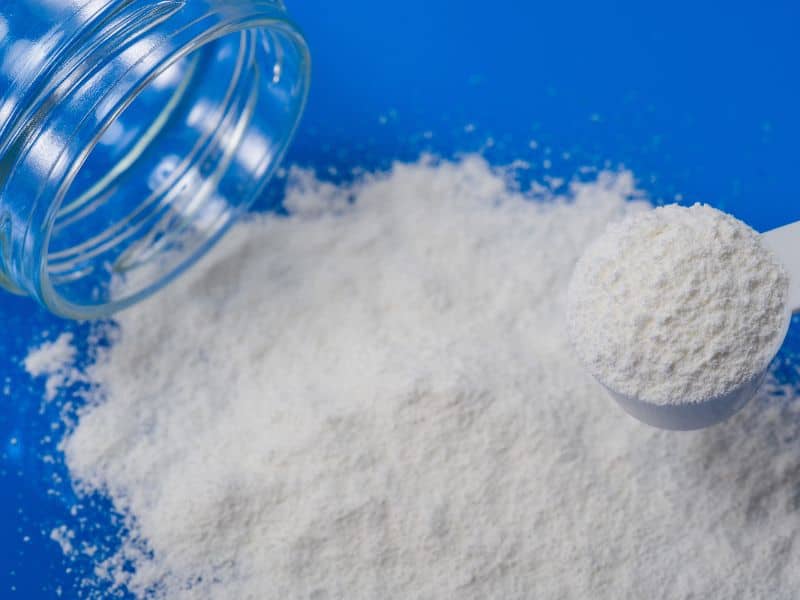Soap making is a complex process that involves combining sodium hydroxide with fats and oils to create a cleansing product. Sodium hydroxide, also known as lye or caustic soda, is an essential component of soap-making because, without sodium hydroxide, there would be no soap. Let’s take a look at how sodium hydroxide works and the role it plays in soap making.
Sodium Hydroxide helps to convert fats and oils into soap by breaking down fat molecules and creating a salt called “soap” that consists of fatty acid salts. Sodium Hydroxide is an essential component of the chemical reaction called saponification that takes place when soap is produced.
This is the most important part of the soap-making process and without it, the soap would not form correctly and would not be effective for cleansing. Sodium hydroxide also helps to thicken the soap and give it a better texture and consistency.
Sodium Hydroxide Explained
Sodium Hydroxide, also known as caustic soda or lye, is a white solid inorganic compound that appears as little crystals or a white powder. It is highly soluble in water and other polar solvents, making it an ideal ingredient for soap-making. Sodium hydroxide is highly corrosive and can cause severe skin burns, so it is important to handle sodium hydroxide with caution.
Where Does It Come From?
Sodium hydroxide can be produced in a variety of ways, but the most common method is sodium hydroxide being derived from sodium carbonate, which is also known as soda ash. This process involves sodium chloride (salt) and calcium hydroxide (lime), which react to form sodium hydroxide.
The Importance For Soap Making
As we have seen, sodium hydroxide is an essential ingredient in soap-making. It helps to convert fats and oils into soap by breaking down fat molecules and creating a salt called “soap” that consists of fatty acid salts. Without sodium hydroxide, the saponification process would not take place, meaning that no soap would be produced.
Sodium hydroxide also helps to thicken the soap and give it a better texture and consistency. It is important to handle sodium hydroxide with caution due to its highly corrosive nature, but when used correctly, sodium hydroxide can produce top-quality soaps that are both effective and enjoyable to use.
Therefore, sodium hydroxide plays an essential role in soap making and should not be overlooked or underestimated. It is a key ingredient that helps to ensure the success of the saponification process and produces high-quality soaps that cleanse effectively and smell great. Thanks to sodium hydroxide, we can all enjoy using quality soaps that leave us feeling clean and refreshed.
Benefits and Risks Associated with Sodium Hydroxide in Soap Making
Benefits of Using Sodium Hydroxide
Sodium hydroxide has a lot of benefits for its soap-making uses given how widely used and accepted it is in the industry. Let’s take a look.
- Sodium hydroxide helps to create a good lather and gives the soap a better texture.
- It helps to break down fats and oils into sodium salts, which are more soluble in water.
- Sodium hydroxide is inexpensive, making it an ideal ingredient for making soap at home.
Now let’s take a look at some of the risks associated with using sodium hydroxide.
Risks Associated With Using Sodium Hydroxide
Sodium hydroxide is important for the soap-making process but that doesn’t mean that it isn’t without its risks. Let’s take a look at some of the risks associated with sodium hydroxide now.
- Sodium Hydroxide is highly corrosive
- Must be handled with care and protective gloves
- Hazardous to skin, eyes, and lungs if inhaled
- Sodium hydroxide can cause burns if left on the skin for too long
Let’s look at some safety tips that might come in handy when working with sodium hydroxide.
Sodium Hydroxide Safety Tips
Here are a few safety tips to keep in mind when working with sodium hydroxide.
- Always wear protective gloves, goggles, and a face mask
- Keep sodium hydroxide away from children
- Be sure to always use sodium hydroxide in a well-ventilated area
- Always read the safety instructions on sodium hydroxide before using it
Sodium Hydroxide is an important ingredient in soap making, but it is important to remember that sodium hydroxide can be dangerous and must be handled with care. Following the safety tips above will help you stay safe when working with sodium hydroxide for soap-making purposes.
Knowing about sodium hydroxide’s role in soap making, the benefits and risks associated with sodium hydroxide, and the safety tips for using sodium hydroxide will keep you safe and help to ensure successful soap-making results.
How Do You Store Sodium Hydroxide?
Let’s take a look at how to properly store sodium hydroxide.
It is important to store sodium hydroxide in an airtight container and away from direct sunlight. It should also be kept away from any other chemicals or materials that could be corrosive or flammable.
Sodium hydroxide should be stored in a cool and dry location, out of the reach of children.
It is important to always read the safety warnings on sodium hydroxide before using it for soap-making purposes.
It is important to make sure that it is in an air-tight container to help make sure that it will not draw moisture. If absorbs moisture while in storage it can cause problems later when you are trying to use it to make soap.
Knowing how to store sodium hydroxide properly will help keep you safe when working with this highly corrosive material.
Frequently Asked Questions
No, sodium hydroxide does not expire. However, sodium hydroxide can absorb moisture from the air and become less effective over time.
Some alternatives to sodium hydroxide for soap-making include potassium hydroxide, sodium lactate, and sodium citrate. However, sodium hydroxide is still the most commonly used ingredient in soap-making due to its effectiveness and affordability.
Yes, sodium hydroxide can also be used as a cleaning agent and preservative. It is also used in the production of paper, textiles, and other products.
Yes, sodium hydroxide is a highly corrosive chemical that can cause severe skin burns if not handled with extreme caution. Always wear protective gloves, goggles, and a face mask when handling sodium hydroxide.
No, sodium hydroxide should never be used directly on the skin as it can be highly damaging. If sodium hydroxide comes into contact with the skin, it should be washed off immediately with water.
.
Conclusion
In conclusion, sodium hydroxide is an important ingredient in soap making. It helps to break down fats and oils into sodium salts which are more soluble in water. While sodium hydroxide has many benefits for its soap-making uses, it also comes with some risks that must be handled with care.
Knowing about sodium hydroxide’s role in soap making, the benefits and risks associated with sodium hydroxide, and the safety tips for using sodium hydroxide will keep you safe and help to ensure successful soap-making results. Finally, remember to always store sodium hydroxide in an airtight container and away from direct sunlight. Doing so will help ensure that sodium hydroxide remains effective and safe for use.






